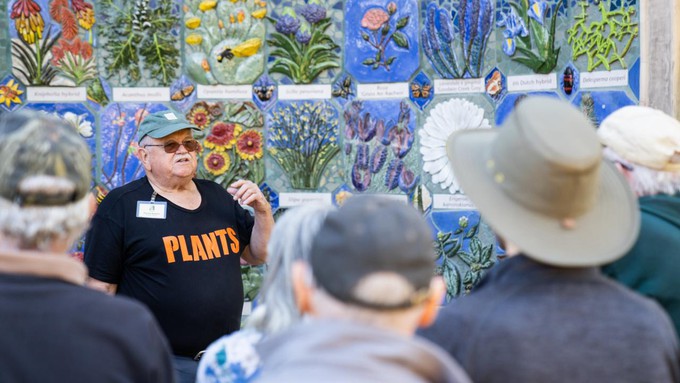
Popular tour led by Warren Roberts highlights spring flowers in the public gardens

Enjoy the knowledge -- and the sense of humor -- of Warren Roberts during his free arboretum tour Wednesday. Courtesy UC Davis Arboretum
Who’s ready for a walk with Warren?
Everybody’s favorite garden guide and raconteur returns Wednesday, April 9, to guide a tour of the UC Davis Arboretum’s gardens in bloom.
Warren Roberts, the Arboretum’s superintendent emeritus, will lead one of his popular monthly walks through the gardens. Meet at noon at the Shields Gazebo, located in the arboretum’s White Flower Garden south of Garrod Drive and the Arboretum Teaching Nursery on the UC Davis campus. The walk is scheduled to be 1 hour long.
With warm and sunny weather, this walk should be special as spring flowers fill the gardens.
“Get ready to immerse yourself in the vivid beauty of spring as you embark on a midday adventure through the gardens and collections of the UC Davis Arboretum with your guide Warren Roberts, superintendent emeritus,” say the organizers. “Renowned for his captivating storytelling and playful puns, Warren leads participants on an always-engaging exploration of the Arboretum’s seasonal highlights.
“Whether you’re a seasoned plant enthusiast or simply eager to revel in the tranquility of nature, this experience promises to be both educational and delightful,” they add. “This event is open to all and free of charge, encouraging everyone to come together and embrace the wonders of nature within the Arboretum’s picturesque grounds.”
Admission to the arboretum and the tour are free, but parking is not. Hourly parking ($1.75) is available along Garrod Drive. Or plan to stay longer and park in nearby Lot 55 with an all-day parking pass ($15).
Details and directions: https://arboretum.ucdavis.edu/.
Roberts' next tour will be noon Wednesday, May 8.
Comments
0 comments have been posted.Sacramento Digs Gardening to your inbox.
Sites We Like
Garden Checklist for week of April 21
This week there’s plenty to keep gardeners busy. With no rain in the immediate forecast, remember to irrigate any new transplants.
* Weed, weed, weed! Get them before they flower and go to seed.
* April is the last chance to plant citrus trees such as dwarf orange, lemon and kumquat. These trees also look good in landscaping and provide fresh fruit in winter.
* Smell orange blossoms? Feed citrus trees with a low dose of balanced fertilizer (such as 10-10-10) during bloom to help set fruit. Keep an eye out for ants.
* Apply slow-release fertilizer to the lawn.
* Thoroughly clean debris from the bottom of outdoor ponds or fountains.
* Spring brings a flush of rapid growth, and that means your garden is really hungry. Feed shrubs and trees with a slow-release fertilizer. Or mulch with a 1-inch layer of compost.
* Azaleas and camellias looking a little yellow? If leaves are turning yellow between the veins, give them a boost with chelated iron.
* Trim dead flowers but not leaves from spring-flowering bulbs such as daffodils and tulips. Those leaves gather energy to create next year's flowers. Also, give the bulbs a fertilizer boost after bloom.
* Pinch chrysanthemums back to 12 inches for fall flowers. Cut old stems to the ground.
* Mulch around plants to conserve moisture and control weeds.
* From seed, plant beans, beets, cantaloupes, carrots, corn, cucumbers, melons, radishes and squash.
* Plant onion sets.
* In the flower garden, plant seeds for asters, cosmos, celosia, marigolds, salvia, sunflowers and zinnias.
* Transplant petunias, zinnias, geraniums and other summer bloomers.
* Plant perennials and dahlia tubers for summer bloom.
* Mid to late April is about the last chance to plant summer bulbs, such as gladiolus and tuberous begonias.
* Transplant lettuce seedlings. Choose varieties that mature quickly such as loose leaf.